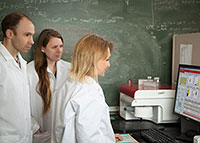Biology Researcher’s Studies of E. coli Impact Ability to Better Predict Evolutionary Responses

From left, Cooper, Ph.D. student Rachel Staples, and postdoctoral fellow Andrea Wünsche record the fluorescence of thousands of individual cells using a flow cytometer. This data is used to calculate the relative fitness of competing bacterial strains.Timothy Cooper has the ability to go back in time – at least when it comes to comparing the evolutionary changes in several thousand generations of Escherichia coli bacteria.
Cooper, an associate professor of biology and biochemistry at the University of Houston, won a five-year National Science Foundation (NSF) CAREER Award worth $967,000 to continue his study of the causes and consequences of evolvability in bacterial populations.
NSF CAREER Awards are one of the most prestigious grants given to promising junior faculty members. Recipients exemplify the role of teacher-scholars through outstanding research, excellent education and the integration of education and research.
“Biological populations have the capacity to adapt to changing conditions – called evolvability. By studying how generations of bacteria evolve over time, we are learning ways to predict the outcome of the changes and to understand what drives the differences in the way strains of bacteria evolve – what are the mechanisms behind the changes,” Cooper said.
Evolutionary Winners and Losers
Evolvability plays a crucial role in determining evolutionary winners (those that improve) and losers (those that become extinct). Through his research, Cooper wants to generate the ability to predict evolutionary winners and losers from the many variants that arise in any bacterial population.
“An understanding of the genetic and physiological basis of evolvability is relevant to fields such as vaccine and antibiotic design, where we want to counter it, and also in biotechnology, where we want to exploit it,” Cooper said.
His research with the bacteria E. coli began 10 years ago with the first petri dish of the fast-growing bacteria.
“We are lucky; the experiments are incredibly simple,” he said. “We grew the first bacteria on a petri dish and took a sample to grow in a test tube with fresh media.”
That process goes on day after day with the bacterial populations growing and a sample being taken from each test tube culture. Cooper now has a set of experimental populations that have evolved for more than 7,000 generations.
Looking Back in Time
The simplicity is deliberate, so that Cooper’s research team can track back what has happened to the strain. But how does he look back in time?
“Every 500 generations, which is about every two months, we freeze a sample of each evolving population creating a living fossil record,” Cooper said. “Because the frozen samples are revivable, we can compare a past population with its future population.”
The comparative analysis of these past and future populations involves genome sequencing. It allows Cooper’s research team, which will include a UH postdoctoral fellow, two graduate students and an undergraduate student, to determine the underlying genetic changes that have occurred and look at the effect of those changes.
At this point, they predict an average of about 15 genetic changes to have occurred in each population evolved for 7,000 generations. Though that number seems small, it is sufficient enough to increase the bacteria’s growth rate by up to 50 percent, Cooper says.
Cooper hopes this type of evolutionary biology research will impact medical care by generating the ability to predict the evolutionary paths of bacterial populations.
“For example, one day we may be able isolate a bacterial pathogen from a patient and be able to predict the likelihood that it will become resistant to a particular antibiotic,” Cooper said.
- Kathy Major, College of Natural Sciences and Mathematics |

